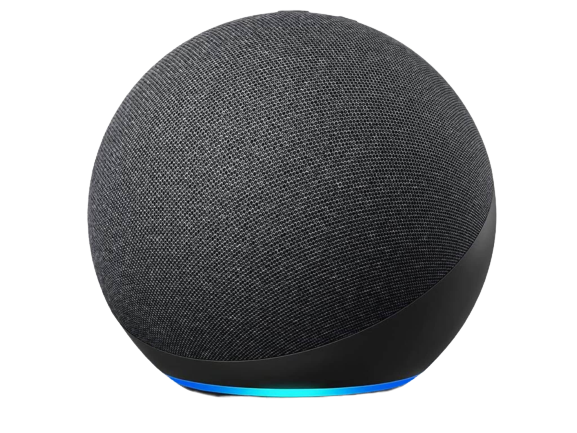Amazon Alexa, also known simply as Alexa, is a virtual assistant technology largely based on a Polish speech synthesizer named Ivona, bought by Amazon in 2013. It was first used in the Amazon Echo smart speaker and the Echo Dot, Echo Studio, and Amazon Tap speakers developed by Amazon Lab126. It is capable of voice interaction, music playback, making to-do lists, setting alarms, streaming podcasts, playing audiobooks, and providing weather, traffic, sports, and other real-time information, such as news. Alexa can also control several smart devices using itself as a home automation system. Users are able to extend the Alexa capabilities by installing “skills” (additional functionality developed by third-party vendors, in other settings more commonly called apps) such as weather programs and audio features. It uses automatic speech recognition, natural language processing, and other forms of weak AI to perform these tasks.
Alexa was developed out of a predecessor named Ivona which was invented in Poland, inspired by 2001: A Space Odyssey, and bought by Amazon in 2013. In November 2014, Amazon announced Alexa alongside the Echo. Alexa was inspired by the computer voice and conversational system on board the Starship Enterprise in science fiction TV series and movies, beginning with Star Trek: The Original Series and Star Trek: The Next Generation.
Amazon developers chose the name Alexa because it has a hard consonant with the X, which helps it be recognized with higher precision. They have said the name is reminiscent of the Library of Alexandria, which is also used by Amazon Alexa Internet for the same reason.

HERE 5 THINGS ALEXA CAN DO FOR YOU ASIDE FROM PLAYING YOU ODOGWU BY BURNA BOY!
Alexa can perform a number of preset functions out-of-the-box such as set timers, share the current weather, create lists, access Wikipedia articles, and many more things. Users say a designated “wake word” (the default is simply “Alexa”) to alert an Alexa-enabled device of an ensuing function command. Alexa listens for the command and performs the appropriate function, or skill, to answer a question or command. When questions are asked, Alexa converts sound waves into text which allows it to gather information from various sources. Behind the scenes, the data gathered is then sometimes passed to a variety of sources including WolframAlpha, iMDB, AccuWeather, Yelp, Wikipedia, and others to generate suitable and accurate answers
- Home automation
In the home automation space, Alexa can interact with devices from several manufacturers including SNAS, Fibaro, Belkin, ecobee, Geeni, IFTTT, Insteon, LIFX, LightwaveRF, Nest, Philips Hue, SmartThings, Wink, and Yonomi. The Home Automation feature was launched on April 8, 2015. Developers are able to create their own smart home skills using the Alexa Skills Kit.
In September 2018, Amazon announced a microwave oven that can be paired and controlled with an Echo device. It is sold under Amazon’s AmazonBasics label.
Alexa can now pair with a Ring doorbell Pro and greet visitors and leave instructions about where to deliver packages.
2. Ordering
Take-out food can be ordered using Alexa; as of May 2017, food ordering using Alexa is supported by Domino’s Pizza, Grubhub, Pizza Hut, Seamless, and Wingstop. Also, users of Alexa in the UK can order meals via Just Eat.[50] In early 2017, Starbucks announced a private beta for placing pick-up orders using Alexa. In addition, users can order meals using Amazon Prime Now via Alexa in 20 major US cities. With the introduction of Amazon Key in November 2017, Alexa also works together with the smart lock and the Alexa Cloud Cam included in the service to allow Amazon couriers to unlock customers’ front doors and deliver packages inside.
According to an August 2018 article by The Information, only 2 percent of Alexa owners have used the device to make a purchase during the first seven months of 2018 and of those who made an initial purchase, 90 percent did not make a second purchase.
3. Music
Alexa supports many subscription-based and free streaming services on Amazon devices. These streaming services include Prime Music, Amazon Music, Amazon Music Unlimited, Apple Music, TuneIn, iHeartRadio, Audible, Pandora, and Spotify Premium. However, some of these music services are not available on other Alexa-enabled products that are manufactured by companies external to its services. This unavailability also includes Amazon’s own Fire TV devices or tablets.
Alexa is able to stream media and music directly. To do this, Alexa’s device should be linked to the Amazon account, which enables access to one’s Amazon Music library, in addition to any audiobooks available in one’s Audible library. Amazon Prime members have an additional ability to access stations, playlists, and over two million songs free of charge. Amazon Music Unlimited subscribers also have access to a list of millions of songs.
Amazon Music for PC allows one to play personal music from Google Play, iTunes, and others on an Alexa device. This can be done by uploading one’s collection to My Music on Amazon from a computer. Up to 250 songs can be uploaded free of charge. Once this is done, Alexa can play this music and control playback through voice command options.
4. Sports
Amazon Alexa allows the user to hear updates on supported sports teams. A way to do this is by adding the sports team to the list created under Alexa’s Sports Update app section.
The user is able to hear updates on 15 supported sports leagues.
5. Messaging and calls
There are a number of ways messages can be sent from Alexa’s application. Alexa can deliver messages to a recipient’s Alexa application, as well as to all supported Echo devices associated with their Amazon account. Alexa can send typed messages only from Alexa’s app. If one sends a message from an associated Echo device, it transmits as a voice message. Alexa cannot send attachments such as videos and photos.
For households with more than one member, one’s Alexa contacts are pooled across all of the devices that are registered to its associated account. However, within Alexa’s app, one is only able to start conversations with its Alexa contacts. When accessed and supported by an Alexa app or Echo device, Alexa messaging is available to anyone in one’s household. These messages can be heard by anyone with access to the household. This messaging feature does not yet contain password protection or an associated PIN. Anyone who has access to one’s cell phone number is able to use this feature to contact them through their supported Alexa app or Echo device. The feature to block alerts for messages and calls is available temporarily by utilizing the Do Not Disturb feature.
Culled from Wikipedia


